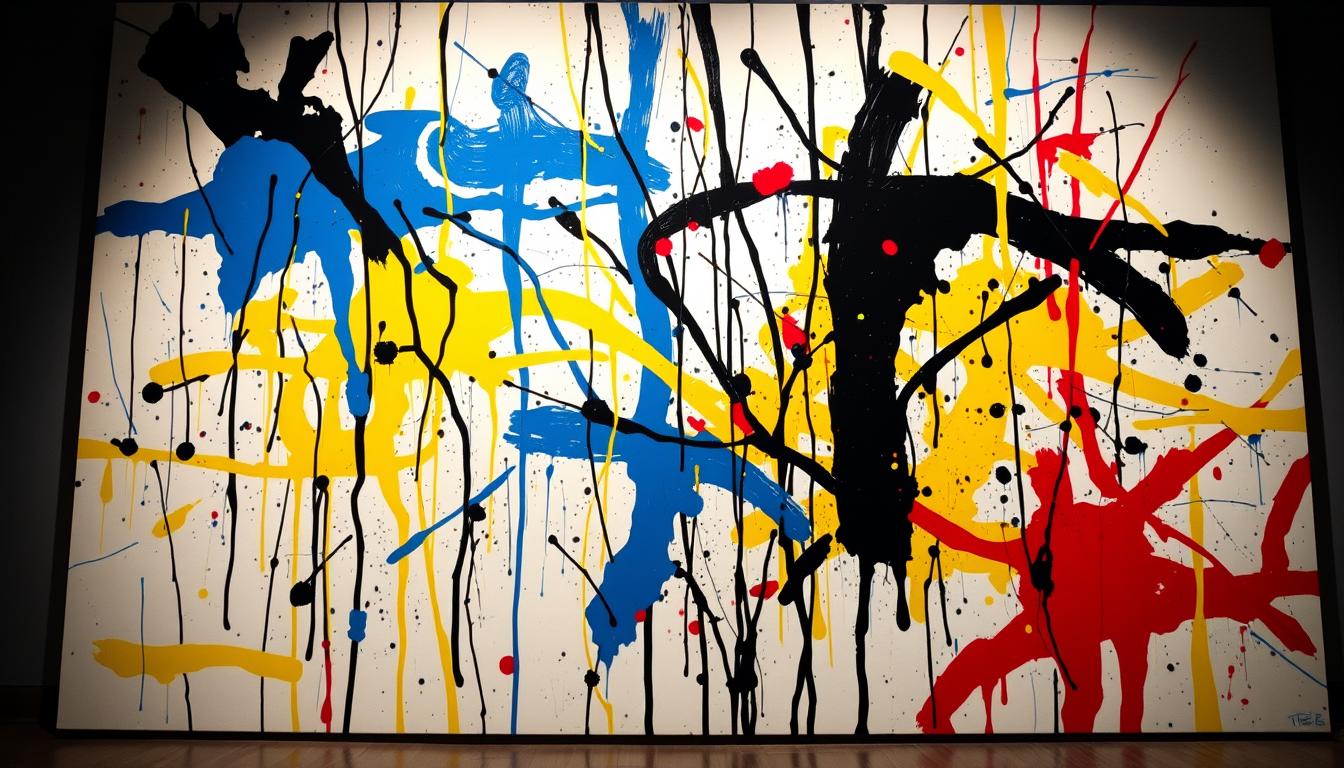Could one artist change how we see paint on canvas? Jackson Pollock rose from New York WPA studios to lead American modern art. His drip method upended composition by removing a single focal point and making the whole surface active.
Pollock—born Paul Jackson Pollock—earned the nickname Jack the Dripper as critics and magazines thrust him into the spotlight. Peggy Guggenheim’s 1943 commission for Mural and a 1949 Life spread sped his fame and market value.

Later sections will explain why his paintings became so costly and how much a Pollock painting was worth, with dates, auction figures, and the market drivers behind headline prices like the estimated $140 million Mural valuation.
Key Takeaways
- He invented a signature drip technique that reshaped modern art.
- Life magazine and Guggenheim patronage accelerated his fame.
- Lee Krasner’s support influenced his career and legacy.
- Pollock often numbered works to avoid imposed meaning.
- We will detail price drivers and notable valuations later in the article.
What are 5 facts about Jackson Pollock?
Pollock’s rise mixed bold studio experiments, influential patrons, and national press into a narrative that still lifts market value today.
He pioneered a floor-based technique
Between 1947 and 1950, he developed the signature drip method and embraced “all-over” composition. Industrial paints were poured, flung, and dripped on canvas laid on the floor, breaking traditional focal rules and reshaping abstract expressionism.
Life magazine amplified national attention
In 1949 life asked if he might be the greatest living painter in the united states. The feature polarized readers and critics, turning him into a cultural lightning rod.
Peggy Guggenheim backed early shows
peggy guggenheim gave him a first solo show in 1943 and commissioned the monumental Mural, providing a key platform in New York’s avant‑garde scene.
Lee Krasner shaped work and routine
lee krasner influenced his methods and steadied his studio life during crucial years of innovation.
International reputation, domestic life
He exhibited overseas yet never travelled outside the United States—an odd contrast that added to his myth.
- Why it matters: Technique, media, patrons, and persona together explain high demand and premium prices for his paintings.
From New York City to the world: the making of an abstract expressionist icon
Pollock’s formative New York years fused formal training, public projects, and radical workshops into the language he later mastered.
Early training with Thomas Hart Benton at the Art Students League
He studied with Thomas Hart Benton at the league new York studio, learning strong draftsmanship and mural scale. This grounding in figure and movement helped when he later abandoned easel traditions for full‑surface canvases.
WPA Federal Art Project and the Siqueiros Experimental Workshop
Manual Arts high school and early spiritual interests nudged him beyond literal subjects. WPA support in the mid‑years provided steady work and contacts with other artists. David Siqueiros’s experimental lab tested industrial paints and techniques that foreshadowed the drip.

“Jack the Dripper”: how critics shaped the artist’s public image
Press in york city popularized the “Jack the Dripper” label, turning studio risks into a cultural story. Early exhibitions and networks led to Guggenheim patronage and museum shows. That New York formation created the innovations whose rarity and influence raised both reputation and market value.
For context on the broader movement, see abstract expressionism.
Inside the studio: technique, process, and the myth of the “controlled accident”
Pollock’s studio practice transformed paint application into a staged performance around an unstretched canvas. He laid raw canvas on the floor and moved around it, turning painting into an active choreography.
Canvas on the floor, industrial paints, and rhythmic movement
He used industrial enamels, oil, sticks, trowels, and hardened brushes to drip and fling paint. The physical setup made the process a full-body act and created layered textures collectors prize.
All-over compositions without a focal point
The result was an all-over field with no single focus. Eyes roam across surface tensions, and that open space redefined pictorial depth in modern painting.
From drip to Black Pourings and darker palettes
Pollock called his approach a “controlled accident.” That phrase captured a balance of spontaneity and trained control in the creative process. Around 1955 he moved toward darker Black Pourings, showing the technique’s evolution.
- Studio traces matter: footprints, drips, and even trapped insects lend authenticity to pollock work and help justify market value.
Signature works that changed modern art
A handful of named masterworks anchored a new scale and ambition for mid‑century American painting.

Mural, Convergence, and Alchemy: breakthroughs of scale and energy
Mural, commissioned by Peggy Guggenheim, announced Pollock’s leap to monumental scale. Its energy set a tone that collectors and museums could not ignore.
Convergence and Alchemy pushed dense layering and surface complexity that carried well in every major show.
Lavender Mist, Autumn Rhythm, and One: Number 31, 1950
These apex works crystallized the drip era. They show compositional mastery that shaped critical opinion and exhibition rosters.
Number 17A and Blue Poles: icons of postwar painting
Number 17A and Blue Poles became familiar even beyond specialist circles. Provenance and public display made them touchstones for the art world.
Shimmering Substance, The Deep, and Lucifer: beyond the drip
Other works show range—coloristic subtlety, psychological depth, and experimentation beyond pure technique. They broaden the artist’s appeal to different collector types.
Why these works matter: repeated exhibitions, scholarly citations, and museum presence increase desirability. That history underpins high valuations at auction and in private sales.
| Work | Year | Impact |
|---|---|---|
| Mural | 1943 | Set monumental scale; launched mature phase |
| Convergence | 1952 | Dense layering; major exhibitions |
| Lavender Mist | 1950 | Apex drip composition; collector demand |
| Blue Poles | 1952 | High visibility; national landmark |
Critical champions, exhibitions, and lasting influence
Institutional shows and vocal critics turned studio experiments into lasting public value.
Clement Greenberg championed the work early and helped shift attention beyond small circles. His advocacy and the Bennington solo show in 1952 gave a decisive scholarly push.
Curation, critics, and public platforms
Major exhibitions mattered. A 1943 solo show at Art of This Century, a 1950 Venice presentation, and eight works in MoMA’s 15 Americans (1952) widened audiences internationally.
Later surveys—15 Years of Jackson Pollock (1955) at Sidney Janis and MoMA’s 1956 mid‑career exhibition—built a durable record. These events made curators and collectors take modern art and the artist seriously.
- Why it helped: museum modern platforms boosted authenticity and scholarly citation.
- Critics’ role: professional critics framed him as a leader among artists, raising collector confidence.
- Market effect: solid exhibition history supports long‑term demand and price strength.
In short, steady critical backing plus high‑profile exhibitions created a lasting foundation for reputation and market value.
Value and legacy: Why is Pollock’s painting so expensive?
A mix of radical technique, limited supply, and steady museum demand explains high prices for his work.
Innovation and influence: the premium on a foundational figure
He changed how painting could act on a surface. As a key postwar painter, his drip era and all‑over compositions rewired modern art language.
That pioneering role gives any canonical pollock work added prestige and price power.
How much is a Pollock painting worth?
Values vary by size, date, condition, and history. A concrete benchmark is the Mural estimate often cited near 140 million.
Other top‑tier paintings have set record private and auction prices, but exact sums depend on provenance and market timing.
Scarcity, provenance, and museum demand
He died in a car crash in 1956, which capped his lifetime output and raised scarcity.
Works linked to major shows or museums in the united states and around the world command premiums. Serious collectors value that history above many other factors.
- Core drivers: radical innovation, lasting influence, scarce supply, and strong provenance.
- Benchmark: Mural cited near 140 million illustrates top‑end potential.
In short: innovation, mythic biography, and institutional validation combine so that select paintings remain among the most expensive in modern art.
Conclusion
Conclusion
Tracing jackson pollock’s path from Manual Arts High School and the Art Students League through WPA projects and Siqueiros’s experiments shows how training and risk shaped his work. Early patronage by Pegg y Guggenheim and the first solo show led to the Mural commission and wider attention.
Critical praise, museum exhibitions in new york city, and Lee Krasner’s stewardship after his 1956 car death made select paintings scarce and coveted. The drip technique, all-over process, and strong provenance explain top-tier prices today.
For a concise life summary and landmark dates, see the Pollock biography.
Enhance Your Space with Unique Modern Masterpieces
Are you inspired by the innovative mediums and conceptual depth highlighted in our exploration of contemporary art? You’re not alone! Today’s art enthusiasts are seeking cultural relevance and emotional connections in their artwork. However, finding pieces that resonate with modern themes and fit your unique style can be a challenge. That’s where we come in!
At Rossetti Art, we specialize in canvas prints, original paintings, and modern sculptures that celebrate the spirit of now. Each piece created by Chiara Rossetti brings a personal touch that connects deeply with current social narratives—just like the modern masterpieces discussed in the article. Don’t miss out on the chance to elevate your home decor with breathtaking artwork that speaks to your values and aesthetic. Explore our collection today and find your perfect piece! Act now, and transform your space into a gallery of inspiration!
FAQ
Who pioneered the drip technique and the “all-over” painting that defined abstract expressionism?
Jackson Pollock developed the signature drip method in the late 1940s, laying canvases on the floor and using sticks, trowels, and hardened brushes to fling and pour household enamels. This approach created dense, all-over compositions without a single focal point and helped establish Abstract Expressionism as a leading movement in American modern art.
How did Life magazine affect his career and fame in the United States?
A 1949 Life magazine feature introduced Pollock’s work to a wide national audience and nicknamed him “Jack the Dripper.” The article amplified public interest, increased demand from collectors, and shifted his status from a New York avant-garde painter to a household name in postwar America.
What role did Peggy Guggenheim play in his early success?
Peggy Guggenheim provided critical support by organizing Pollock’s first major solo show in 1943 and commissioning the large-scale Mural that solidified his reputation. Her patronage offered visibility, a crucial network, and financial backing during formative years.
How did Lee Krasner influence his life and work?
Lee Krasner, an accomplished painter and his wife, influenced Pollock’s creative direction, critiqued his compositions, and helped manage his career. She also stabilized his domestic life, preserved his legacy after his death, and promoted his work within museum and collector circles.
Did he travel and exhibit internationally during his lifetime?
Despite worldwide acclaim and exhibitions in major museums, Pollock never visited a country outside the United States. His travels remained domestic, with New York City as the center of his life and career.
Where did he study and who were his early instructors?
Pollock trained at the Art Students League in New York under Thomas Hart Benton, whose figurative, rhythmic style influenced Pollock’s early work. He also participated in the WPA Federal Art Project before moving toward abstraction.
What impact did the Siqueiros Experimental Workshop have on his practice?
At David Alfaro Siqueiros’s workshop in 1936, Pollock learned experimental techniques like using industrial paints and unconventional tools. The collaborative, experimental environment encouraged risk-taking and informed his later drip practice.
Why was he called “Jack the Dripper” by critics?
The nickname came from critics and the press after Life’s profile and reflected both fascination and skepticism. It emphasized his novel method of dripping and pouring paint, which challenged traditional definitions of skill and composition.
How did he arrange his studio and work physically on canvases?
Pollock placed large canvases flat on the studio floor to move around them freely. He used commercial enamels, sand, and household paints, and applied paint through dripping, pouring, and flinging, using whole-body, rhythmic motions to build complex surfaces.
What distinguishes his “all-over” compositions?
All-over paintings avoid a single center of interest. Pollock distributed marks evenly across the surface, creating immersive fields of interlaced line and color that engage viewers from multiple angles and resist traditional hierarchy in painting.
How did his palette and style change in the mid-1950s?
In the 1950s Pollock shifted toward darker tones and heavier, more somber surfaces, producing works often called the Black Pourings. These pieces show denser textures and a brooding mood compared with his earlier, lighter color fields.
Which signature works marked major milestones in his career?
Key paintings include Mural (1943), which launched him to prominence; One: Number 31, 1950 and Autumn Rhythm, which showcase his peak drip technique; Lavender Mist, Convergence, Number 17A, and Blue Poles, each notable for scale, energy, and impact on modern art.
Are there well-known works beyond the drip canvases?
Yes. Works like Shimmering Substance, The Deep, and Lucifer explore varied approaches and textures beyond classic drips, demonstrating his range and continued experimentation across his career.
Who championed his work among critics and institutions?
Critics such as Clement Greenberg and exhibitions like MoMA’s American-focused shows helped validate Pollock for museums and collectors. Support from prominent critics and curators accelerated his acceptance into the mainstream art world.
Why do his paintings command such high prices today?
Value stems from innovation, historical significance, scarcity, and strong provenance. As a foundational figure in American modern art, his paintings attract major museums and wealthy collectors, which drives auction records and high market estimates.
How high have sale prices gone for his work?
Prices have reached the tens of millions, with market estimates sometimes cited around $140 million for top works. Record sales depend on attribution, condition, and provenance, and museums often vie for the most important pieces.
What factors increase a painting’s market value?
Scarcity, documented provenance, exhibition history, condition, and inclusion in major collections or museum shows all raise value. A Pollock with strong exhibition credentials and clear ownership history will fetch a premium.
Where can people see his work today?
Major museums in New York City, including the Museum of Modern Art and the Metropolitan Museum of Art, hold important Pollocks. Other institutions worldwide and notable private collections also display his paintings in rotating exhibitions.
How did his life end and did it affect his legacy?
Pollock died in a 1956 car crash in New York State. His sudden death intensified public and critical interest, and Lee Krasner worked to preserve and promote his oeuvre, ensuring his lasting place in 20th-century art history.






Leave a comment
This site is protected by hCaptcha and the hCaptcha Privacy Policy and Terms of Service apply.